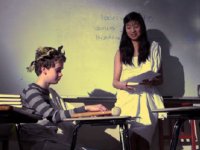How Storytelling Inspires Children to Learn English
When you engage your English-language learners through the power, fun, and sharing of narrative, the formal elements of language acquisition will follow more easily.
Storytelling has tremendous benefits for classroom learning, as I discussed in my post Why Storytelling in the Classroom Matters. This time, I want to further explore those benefits, in particular how storytelling inspires children to learn English.
The motivation for this comes from my recent experience of teaching in an international school in China that has a 97 percent cohort of students learning English as an additional language (EAL). In my Grade 3 class last year, I had four students join with no English and as many again with very basic language skills. I worried that I would struggle to engage these students as both a teacher and a storyteller.
The Power of Story
I set aside my worries and started telling stories in the manner described in my earlier post. However, I quickly adapted my style for my new class. These adaptions were:
- I spoke slower, putting more dramatic emphasis into my voice.
- I used more physical actions and sound effects to help associate universally recognised body actions (running, sleeping, etc.) with new English words.
- I frequently asked the audience to repeat key words and actions.
- I used more physical humour. Laughter was essential to breaking down the barrier of language.
After a few months of this, I started receiving some of the biggest surprises of my career. Firstly, a German student who was in the listening phase of language acquisition began spontaneously writing her own fairy tales and requested to tell them -- the first student storyteller. She was quickly followed by a Japanese student who had been enjoying himself as an actor in the stories but was always nervous about speaking English. Now he started telling short but lively stories that he had written. Several Korean students then started sharing stories, overcoming shyness and worries about publicly making mistakes.
Within a month, I had a list of students wanting to tell stories, and this continued for the rest of the year, right up to the very last day of term. Those first EAL storytellers went on to make rapid progress in the wider curriculum, with writing and telling fiction remaining their favourite activity. Over the summer, I reflected on why storytelling had been so powerful in inspiring English communication. I concluded:
- Stories are innately part of human experience, in any language. Storytelling is the one commonality between all world cultures, regardless of literacy rates.
- Children naturally inhabit fantasy worlds, and stories are a natural way for them to express language and emotion.
- With a beginning, middle, and end, stories have a structure that creates a sense of achievement.
- When peers appreciate your story, it is a big boost to confidence.
- It's great fun seeing your friends act out your story, dressing in costumes and using props. Fun is the best motivation.
- Storytelling doesn't require complex, technical vocabulary. Think of silent films and comics. Sophisticated narrative can be understood with few words.
- I don't worry about the student's spelling, grammar, and handwriting at this stage. A focus on these areas can easily demotivate and inhibit creativity. There must be freedom to take risks and make mistakes.
Beyond the Language Barrier
In my previous post on this topic, you'll find a breakdown of the skills to help you become a storyteller. In terms of working with students new to English, I have adapted my technique in the following manner:
- I'm ready to support shy students and help them when they get stuck on a word. Any student who stands up to tell a story in English has made an incredible breakthrough.
- I set my classroom up in a large inverted U shape, which creates a stage space in the centre and means that everybody can see each other and have open, dialogic-style discussions. I am often asked, "How do you do group work if the tables are not grouped together?" That's easy -- students move their chairs or sit anywhere they like.
- Most of my students write their own stories, but some work together, which is wonderful for developing confidence in creativity. Some love to use postcards as imagination prompts or sequence aids.
- Most students draw inspiration from their reading, so a varied book corner is essential in the classroom. This year, two German students worked together to tell a story in English, readers theatre style, which they were translating together from a German book.
- I play lots of language games that I either make up or gain from other storytellers and literacy workshops. They make talking (and laughing) the forefront of language learning.
The ideal situation is finding yourself overwhelmed by student requests. To have problems managing enthusiasm is the best problem a teacher can have. During the last week of term, my students were worried that their next teachers would not let them be storytellers. I can show anyone how to be a storyteller, but I cannot make any teacher try it. Be the teacher who tries, not the teacher who disappoints. Meanwhile, I cannot wait to start all over again with my new class!
Has storytelling helped break the language barrier with your students or in your school? Please tell us about it.
